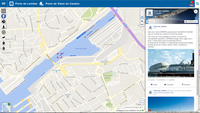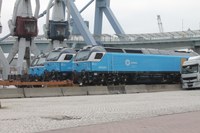Portuguese ports are world pioneers in technological innovation
Portuguese ports are world pioneers in technological innovation
Two of the most technologically advanced ports in the world are Portuguese. The Ports of Leixões and Viana do Castelo, managed by the Port Authority of the Ports of Douro, Leixões and Viana do Castelo (APDL), were the pilot in an innovation project led by INESC TEC and TRIEDE TTI. The tool 3Port makes it possible not only to manage the different needs and business processes of port authorities in an integrated way, but also to interact with the general public, which can see, in real time, what is happening in the port (http://livemap.apdl.pt).


How does the 3Port work?
The goal is for this solution to become an essential tool for the technical services to support and adequately manage processes. With this innovation, which adds value to the port and its activity, strategic areas are interconnected, and structured data are provided and shared in a georeferenced context.
The 3Port is based on eight modules, seven of which are used by the port – hydrography (dredging and navigable areas), port traffic, domain (licenses and concessions), studies and construction work, prevention and security, environment, and registration and assets –, and one is used by the public. Most of these modules have been introduced for the first time in the process management of the Ports of Leixões and Viana do Castelo.
This technology transfer triangle composed of INESC TEC (producer of the innovation), TRIEDE TTI (producer of the solution) and APDL (user of the solution and the one identifying the requirements) makes these ports some of the most innovative worldwide in terms of R&D.


The modules
Hydrography makes it possible to calculate/map the service quotas (navigability) and to calculate silting/sedimentation rates and sediments dredged, characterising all dredging operations.
Port Traffic makes it possible to monitor the port traffic in real time, and to plan and optimise resources (tug boats, bollards, cranes, navigation) when piloting the vessels (mooring and departure manoeuvres).
The Domain (licenses and concessions) module manages and registers the licenced/concession areas, and monitors the port authority’s jurisdiction area.
The Studies and Construction Work module manages, registers and monitors all construction work, as well as all the studies conducted and post-construction monitoring.
All far as Prevention and Security are concerned, the module includes an Internal Security Plan for the port, veering and to support the mitigation of an accident or incident, from the time the alert is given to the time the problem is solved. Also, it provides a homogenous and simplified access to internal security cameras, regardless of the manufacturer or model. Finally, this module manages and provides offline access to critical information.
In the Environment module, the tool characterises, in an environmental way, the port’s area of influence, and collects data in real time using sensors, which makes it possible to provide indicators and issue alerts.
The module Registration and Assets, which is the Foundation of the entire system, makes it possible to define the spatial organisation of the port authority, as well as the background information, and to optimise the use of the existing infrastructure in the port.


The Public area, based on the Live Map module, is basically used as a marketing tool, allowing the user to visualise, in real time, boat traffic in the port. It combines public information with Panoramio (photos), Google and Facebook.
The public component of the 3Port Live Map works not only in computers, but also in tablets and smartphones without having to download an app. This happens because the system adapts to the browser in any mobile device.
The advantages of 3Port
The 3Port is advantageous and promotes a sustainable growth because it supports decision-making and gains in efficiency, while reducing operational costs.
“Another advantage is that the solution adapts itself to the port’s processes and not the other way around. Moreover, the solution is interoperable, which means that it does not replicate information, but rather accesses the location of the information, interacting, in an integrated fashion, with the remaining tools in the port’s ecosystem,” explains Lino Oliveira, the INESC TEC researcher responsible for the project, which took two years to develop.
Based on open source web technologies, the 3Port homogenously integrates both the internal systems in the port and the public information systems.


The goal is to export the 3Port
The goal for now is to export the solution to Brazil, Angola, Chile and Peru.
“We have already presented the 3Port in four Brazilian states, as well as in Luanda (Angola), Valparaíso (Chile) and Callao (Peru), and the international feedback has been tremendous. In Brazil, for instance, we were told that they did not know any solution remotely similar to ours. Besides these four countries, we want to export our solution to the Community of Portuguese-Speaking Countries (CPLP) and to Latin America”, states Mauro Ferreira, the person in charge of the project at TRIEDE TTI.
The INESC TEC researcher mentioned in this article is associated with the following partner institution: INESC TEC.


